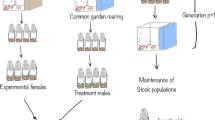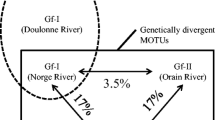Abstract
It is becoming increasingly apparent that at least some aspects of the evolution of mate recognition may be amenable to manipulation in evolutionary experiments. Quantitative genetic analyses that focus on the genetic consequences of evolutionary processes that result in mate recognition evolution may eventually provide an under- standing of the genetic basis of the process of speciation. We review a series of experiments that have attempted to determine the genetic basis of the response to natural and sexual selection on mate recognition in the Drosophila serrata species complex. The genetic basis of mate recognition has been investigated at three levels: (1) between the species of D. serrata and D. birchii using interspecific hybrids, (2) between populations of D. serrata that are sympatric and allopatric with respect to D. birchii, and (3) within populations of D. serrata. These experiments suggest that it may be possible to use evolutionary experiments to observe important events such as the reinforcement of mate recognition, or the generation of the genetic associations that are central to many sexual selection models.
Access this chapter
Tax calculation will be finalised at checkout
Purchases are for personal use only
Preview
Unable to display preview. Download preview PDF.
Similar content being viewed by others
References
Andersson, M., 1994. Sexual Selection. Princeton University Press, New Jersey.
Arnold, S.J., 1992. Constraints on phenotypic evolution. Am. Nat. 140: S85–S107.
Arnold, S.J. & P.C. Phillips, 1999. Hierarchical comparison of genetic variance-covariance matrices. II. Coastal-inland divergence in the garter snake, Thamnophis elegans. Evolution 53: 1516–1527.
Ayala, F.J., 1965. Sibling species of the Drosophila serrata group. Evolution 19: 538–545.
Bakker, T.C.M., 1993. Positive genetic correlation between female preference and preferred male ornament in sticklebacks. Nature 363: 255–257.
Barton, N., 2000. The rapid origin of reproductive isolation. Science 290: 462–463.
Barton, N.H. & M. Turelli, 1987. Adaptive landscapes, genetic distance and the evolution of quantitative characters. Genet. Res. 49: 157–173.
Blows, M.W., 1998. Evolution of a mate recognition system after hybridization between two Drosophila species. Am. Nat. 151: 538–544.
Blows, M.W., 1999. Evolution of the genetic covariance between male and female components of mate recognition: an experimental test. Proc. R. Soc. Lond. B 266: 2169–2174.
Blows, M.W., 2002. Interaction between natural and sexual selection during the evolution of mate recognition. Proc. R. Soc. Lond. B 269: 1113–1118.
Blows, M.W. & R.A. Allan, 1998. Levels of mate recognition within and between two Drosophila species and their hybrids. Am. Nat. 152: 826–837.
Blows, M.W. & M. Higgie. Genetic constraints on the evolution of evolution of mate recognition under natural selection. Am. Nat. (in press).
Bock, I.R., 1976. Drosophilidae of Australia. I. Drosophila (Insecta: Diptera). Aust. J. Zool., Supp. Ser. No. 40.
Bock, I.R., 1984. Interspecific hybridization in the genus Drosophila. Evol. Biol. 17: 41–70.
Breden, F., H.C. Gerhardt & R.K. Butlin, 1994. Female choice and genetic correlations. Trends Ecol. Evol. 9: 343.
Brooks, R., 2000. Negative genetic correlation between male sexual attractiveness and survival. Nature 406: 67–70.
Brooks, R. & V. Couldridge, 1999. Multiple sexual ornaments co-evolve with multiple mating preferences. Am. Nat. 154: 37–45.
Burger, R. & R. Lande, 1994. On the distribution of the mean and variance of a quantitative trait under mutation-selection-drift balance. Genetics 138: 901–912.
Butlin, R.K., G.M. Hewitt & S.F. Webb, 1985. Sexual selection for intermediate optimum in Chorthippus brunneus (Orthoptera: Acrididae). Anim. Behav. 33: 1281–1292.
Butlin, R., 1987. Speciation by reinforcement. Trends Ecol. Evol. 2: 8–13.
Butlin, R., 1989. Reinforcement of premating isolation, pp. 158–179 in Speciation and Its Consequences, edited by D. Otte & J.A. Endler. Sinauer Associates, Sunderland.
Butlin, R., 1995. Reinforcement: an idea evolving. Trends Ecol. Evol. 10: 432–434.
Buckley, S.H., T. Tregenza & R.K. Butlin, 1997. Speciation and signal trait genetics. Trends Ecol. Evol. 12: 299–301.
Carson, H.L., F.C. Val & A.R. Templeton, 1994. Change in male secondary sexual characters in artificial interspecific hybrid populations. Proc. Natl. Acad. Sci. USA 91: 6315–6318.
Cobb, M. & J.M. Jallon, 1990. Pheromones, mate recognition and courtship stimulation in the Drosophila melanogaster species sub-group. Anim. Behav. 39: 1058–1067.
Coyne, J.A., 1992. Genetics of speciation. Nature 355: 511–515.
Coyne, J.A., A.R Crittenden & K. Mah, 1994. Genetics of a phero-monal difference contributing to sexual isolation in Drosophila. Science 265: 1461–1464.
Coyne, J.A. & B. Charlesworth, 1997. Genetics of a pheromone difference affecting sexual isolation between Drosophila mauri-tiana and D sechellia. Genetics 145: 1015–1030.
Coyne, J.A. & H.A. Orr, 1998. The evolutionary genetics of speciation. Phil. Trans. R. Soc. Lond. B 353: 287–305.
Dobzhansky, T., 1951. Genetics and the Origin of Species. Columbia University Press, New York, 3rd edn.
Endler, J.A. & A.E. Houde, 1995. Geographic variation in female preferences for male traits in Poecilia reticulata. Evolution 49: 456–468.
Gray, D.A. & W.H. Cade, 1999. Quantitative genetics of sexual selection in the field cricket Gryllus integer. Evolution 53: 848–854.
Gray, D.A. & W.H. Cade, 2000. Sexual selection and speciation in field crickets. Proc. Natl. Acad. Sci. USA 97: 14449–14454.
Harshman, L.G. & A.A. Hoffmann, 2000. Laboratory selection ex-periments using Drosophila: what do they really tell us? Trends Ecol. Evol. 15: 32–36.
Hasselquist, D., S. Bensch & T. von Schantz, 1996. Correlation between male song repertoire, extra-pair paternity and offspring survival in the great reed warbler. Nature 381: 229–232.
Higgie, M., S. Chenoweth & M.W. Blows, 2000. Natural selec-tion and the reinforcement of mate recognition. Science 290: 519–521.
Hine, E., S. Lachish, M. Higgie & M.W. Blows. Positive genetic correlation between female preference and offspring fitness. Proc. R. Soc. Lond. B (in press).
Hoikkala, A. & S. Crossley, 2000. Copulatory courtship in Dro-sophila: behaviour and songs in D. birchii and D. serrata. J. Insect Behav. 13:71–87.
Houde, A.E., 1994. Artificial selection on male colour patterns shifts mating preferences of female guppies. Proc. R. Soc. Lond. B 256: 125–130.
Houle, D. & A.S. Kondrashov, 2002. Coevolution of costly mate choice and condition-dependent display of good genes. Proc. R. Soc. Lond. B 269:97–104.
Howard, D.J., 1993. Reinforcement: origin, dynamics, and fate of an evolutionary hypothesis, pp. 46–69 in Hybrid Zones and the Evolutionary Process, edited by R.G. Harrison. Oxford University Press, New York.
Howard, R.W., L.L. Jackson, H. Banse & M.W. Blows. Cuticular hydrocarbons of Drosophila birchii and D. serrata: identification and role in mate choice in D. serrata. (in preparation).
Iwasa, Y., A. Pomiankowski & S. Nee, 1991. The evolution of costly mate preferences. II. The “Handicap” principle. Evolution 45: 1431–1442.
Iwasa, Y & A. Pomiankowski, 1995. Continual change in matte preferences. Nature 377: 420–422.
Jallon, J.M., 1984. A few chemical words exchanged by Drosophila during courtship and mating. Behav. Genet. 14: 441–478.
Jennions, M.D., A.P Moller & M. Petrie, 2001. Sexually-selected traits and adult survival: a meta-analysis. Quart. Rev. Biol. 76 3–36.
Keightley, P.D. & W.G. Hill, 1989. Quantitative genetic variability maintained by mutation-stabilizing selection: sampling variation and response to subsequent directional selection. Genet. Res. 54: 45–57.
Kirkpatrick, M., 1987. Sexual selection by female choice in poly-gynous animals. Ann. Rev. Ecol. Syst. 18: 43–70.
Kirkpatrick, M. & N.H. Barton, 1995. Deja vu all over again. Nature 377: 388–389.
Kirkpatrick, M. & N.H. Barton, 1997. The strength of indirect selection on female mating preferences. Proc. Natl. Acad. Sci. USA 94: 1282–1286.
Lande, R., 1979. Quantitative genetic analysis of multivariate evolution, applied to brain: body size allometry. Evolution 33: 402–116.
Lande, R., 1981. Models of speciation by sexual selection on polygenic traits. Proc. Natl. Acad. Sci. USA 78: 3721–3725.
Lynch, M. & B. Walsh, 1998. Genetics and Analysis of Quantitative Traits. Sinauer Associates, Massachusetts.
Nelson, D.R., 1993. Methyl-branched lipids in insects, pp. 271–315 in Insect Lipids: Chemistry, Biochemistry and Biology, edited by D.W. Stanley-Samuelson & D.R. Nelson. University of Nebraska Press, Lincoln.
Noor, M.A., 1995. Speciation driven by natural selection in Dro-sophila. Nature 375: 674–675.
Norris, K., 1993. Heritable variation in a plumage indicator of viability in male great tits Parus major. Nature 362: 537–539.
Orr, H.A., 2001. The genetics of species differences. Trends Ecol. Evol. 16: 343–350.
Partridge, L., 1980. Mate choice increases a component of offspring fitness in fruit flies. Nature 283: 290–291.
Paterson, H.E.H., 1985. The recognition concept of species, pp. 21–29 in Species and Speciation, edited by E. Vrba. Transvaal Museum Monograph 4, Pretoria, South Africa.
Pomiankowski, A. & L. Sheridan, 1994. Linked sexiness and choosiness. Trends Ecol. Evol. 9: 242–244.
Petrie, M., 1994. Improved growth and survival of offspring of peacocks with more elaborate trains. Nature 371: 598–599.
Rice, W.R. & E.E. Hostert, 1993. Laboratory experiments on speciation: what have we learned in forty years. Evolution 47: 1637–1653.
Rundle, H.D. & D. Schluter, 1998. Reinforcement of stickleback mate preferences: sympatry breeds contempt. Evolution 52: 200–208.
Ryan, M.J. & A.S. Rand, 1993. Species recognition and sexual selection as a unitary problem in animal communication. Evolution 47: 647–657.
Schluter, D., 1988. Estimating the form of natural selection on a quantitative trait. Evolution 42: 849–861.
Schluter, D., 1996. Adaptive radiation along genetic lines of least resistance. Evolution 50: 1766–1774.
Schluter, D., 2001. Ecology and the origin of species. Trends Ecol. Evol. 16: 372–380.
Spieth, H.T. & J.M. Ringo, 1983. Mating behaviour and sexual isolation in Drosophila, pp. 223–284 in The Genetics and Biology of Drosophila, Vol. 3C, edited by M. Ashburner, H.L. Carson & J.N. Thompson. Academic Press, London.
Turelli, M., N.H. Barton & J.A. Coyne, 2001. Theory and speciation. Trends Ecol. Evol. 16: 330–343.
Wallace, B., M.W. Timm & M.P.P. Strambi, 1983. The establishment of novel mate recognition systems in introgressive hybrid Drosophila populations. Evol. Biol. 16: 467–488.
Wilkinson, G.S. & RR. Reillo, 1994. Female choice response to artificial selection on an exaggerated male trait in a stalk-eyed fly. Proc. R. Soc. Lond. B 255: 1–6.
Wu, C.-I., H. Hollocher, D.J. Begun, C.F.. Aquadro, Y. Xu & M.-L. Wu, 1995. Sexual isolation in Drosophila melanogasten a possible case of incipient speciation. Proc. Natl. Acad. Sci. USA 92:2519–2523.
Author information
Authors and Affiliations
Editor information
Rights and permissions
Copyright information
© 2002 Springer Science+Business Media Dordrecht
About this chapter
Cite this chapter
Blows, M.W., Higgie, M. (2002). Evolutionary experiments on mate recognition in the Drosophila serrata species complex. In: Etges, W.J., Noor, M.A.F. (eds) Genetics of Mate Choice: From Sexual Selection to Sexual Isolation. Contemporary Issues in Genetics and Evolution, vol 9. Springer, Dordrecht. https://doi.org/10.1007/978-94-010-0265-3_9
Download citation
DOI: https://doi.org/10.1007/978-94-010-0265-3_9
Publisher Name: Springer, Dordrecht
Print ISBN: 978-94-010-3958-1
Online ISBN: 978-94-010-0265-3
eBook Packages: Springer Book Archive




